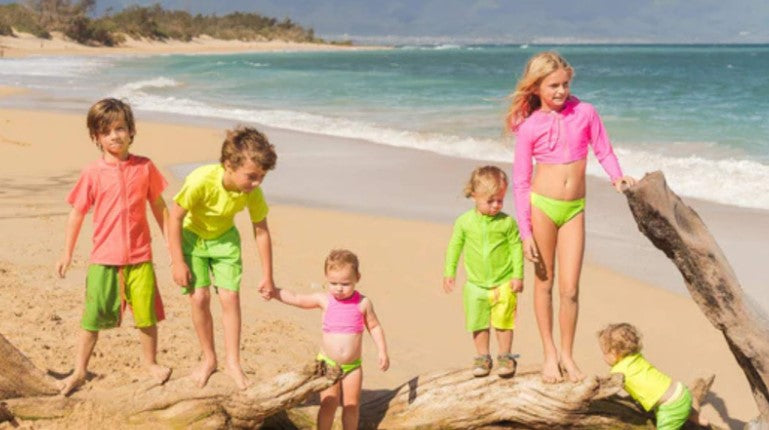
Swimwear colors for kids to avoid (and what to choose instead)
Swimsuit color should be a part of every parent’s safety strategy. What your children wear affects how easily you can see them underwater, in crowds, or far away. Dark colors look cute on kids, but how safe are they?
Quick links:
Why dark colors hide children underwater
Dangers of blue bathing suits in pools
Black swimsuits and visibility problems
Green swimwear risks in natural waters
Patterns that reduce visibility in water
Bright colors that keep kids visible and safe
We’ll explore what color bathing suits to avoid for kids, other swim safety tips, and which colors keep your kids visible and stylish.
The SwimZip neon collection features high-visibility swimwear that stands out in all bodies of water. Our bright swimsuits, rash guards, swim shorts, and more improve your family's visibility in the water and provide UPF 50+ sun protection during water activities.
Why dark colors are hard to see underwater
Darker colors absorb light instead of reflecting it. When submerged, this absorption intensifies. Water naturally filters light, reducing visibility even in clear swimming pools. A dark swimsuit can quickly disappear when submerged.
Distance makes dark colors even harder to see. A child in dark swimwear just 10 feet underwater might not be visible to parents standing poolside. A shadow or harsh sun reflection might totally obscure your vision when looking from an angle.
The contrast between swimmer and water determines how quickly you can spot someone in trouble. This split-second visibility impacts rescue time—a serious issue since people can drown in under 60 seconds.
Dangers of blue swimwear in pools
Most pools have blue surfaces, tiles, liners, or painted concrete bottoms that match blue swimwear. This color similarity reduces contrast. Blue fabric absorbs the same light wavelengths as pool water, causing the swimsuit to blend with the background. A child who swims to the pool bottom in blue swimwear might not be visible.
Black swimsuits and visibility
Black absorbs all light wavelengths, making black swimwear virtually disappear underwater regardless of pool color or water type. Visibility tests conducted at public pools have demonstrated that dark swimwear, including black, significantly reduces detection rates compared to high-visibility neon colors. Lifeguards reported black swimwear as the most difficult to track during water safety drills and emergency simulations.
This invisibility effect occurs in all water conditions but worsens significantly in natural bodies of water, nighttime swimming, or pools with shadows. The risk increases for children who might not signal distress while underwater.
Green swimwear risks in natural waters
Green swimwear is hard to see in lakes, ponds, and other natural water settings. These environments typically contain algae, plants, and green-tinted water that camouflage green swimsuits. Even shallow natural water obscures green swimsuits and poses a safety risk. Debris, particulate, and weather conditions further blend green swimwear into the environment.
Children in green and dark-colored swimwear account for a disproportionate number of delayed rescue attempts. The extra seconds spent locating a child in distress often make a critical difference in outcomes. Water safety experts consistently recommend against green swimwear for this reason.
Patterns that reduce visibility in water
Patterned swimwear might look stylish, but certain designs seriously compromise underwater visibility.
-
Small, busy patterns break up the human silhouette underwater and trick the eye.
-
Dark patterns with blue, green, or black elements blend with water and shadows.
-
Camouflage prints work as intended, they hide children underwater.
-
Striped patterns fragment body shapes underwater, which masks distress signals.
-
Multicolored geometric designs mix bright and dark elements that reduce visibility.
-
Low contrast patterns lack the visual pop needed for quick identification.
Bright colors that keep kids visible and safe
Neon swimwear dramatically increases underwater visibility and provides crucial safety advantages in all water environments.
-
Neon pink stands out against blue water backgrounds and creates maximum contrast even at depth.
-
Neon orange remains visible in clear and murky water conditions for lakes and oceans.
-
Neon yellow offers ultimate visibility, particularly in shadowy pool areas.
-
Neon and lime green cut through visual distortion in water at shallower depths.
These vibrant colors reflect rather than absorb light, which sends a strong visual signal to observers above water. The fluorescent colors amplify available light, so they appear to glow underwater. This visibility of bright neon colors helps lifeguards and parents spot children quickly during emergencies.
SwimZip designs high-visibility swimwear with these safety principles, plus UPF 50+ sun protection for all-day safety in water and sun.
Choose SwimZip high-quality swimwear
SwimZip leads the industry in child water safety with visibility-focused swimwear designs. Our neon collection includes options for all ages and prioritizes visibility without sacrificing style or comfort.
SwimZip neon swimsuits use UPF 50+ fabric that blocks 98% of harmful UV rays and maximizes underwater visibility. Our signature front zipper design simplifies dressing small children, adding convenience to safety.
Parents appreciate how our high-visibility swimwear stays bright even after extensive use. The fabrics resist chlorine damage and maintain their vibrant colors throughout the swimming season and beyond.
In our extensive sun-protective swimwear collection, you will find everything you need: from one-piece rash guards and sunsuits to swim skirts and swim trunks.
Swimsuit colors to avoid FAQ
What are the safest colors to wear in all bodies of water?
Neon colors provide maximum visibility in all water environments. Neon yellow, orange, and pink stand out against water backgrounds because they reflect light. Fluorescent fabrics create this glow effect underwater. Light colors such as bright white also offer good visibility in darker waters.
What are some aquatic safety tips parents should know?
Water safety requires multiple layers of protection beyond visible swimwear. Follow these safety practices:
-
Teach basic swimming skills early through professional instruction.
-
Always use Coast Guard-approved life jackets for non-swimmers and young children.
-
Enroll children in formal swim lessons starting at age 1 or earlier.
-
Maintain constant, undistracted adult supervision within arm's reach of young swimmers.
-
Learn CPR and basic water rescue techniques.
-
Install proper barriers around home pools with self-closing gates.
-
Understand that the signs of drowning differ from movie portrayals as most drowning incidents occur silently and quickly.
-
Establish and enforce water safety rules consistently.
How do environmental factors affect swimwear visibility?
Water clarity, sunlight angle, cloud cover, and surface choppiness impact the visibility of swimmers underwater. Even bright swimwear is harder to see in murky water, during sunset hours, or when surface reflection increases.
Are white swimsuits a good alternative to neon colors?
White swimsuits provide good visibility in darker waters but have limitations. They become nearly transparent when wet, potentially creating modesty issues. White also appears grayish underwater at depth and doesn't create the same contrast as neon colors in most pool environments with light-bottomed pool surfaces.
How can I keep track of my child in a crowded pool or water park?
In a crowded pool environment, bright swimwear becomes even more important. Combine high-visibility swimwear with meeting points, buddy systems, and regular check-ins. Some families use matching bright bathing suits for easier identification across distances.
What features make water parks challenging environments for visibility?
Water parks combine varying depths, churning water, splash zones, blue surfaces, structures and their shadows, and crowds. The constant movement makes bright-colored swimwear especially important.
How do bright-colored swimsuits help lifeguards identify signs of drowning?
Lifeguards can spot signs of drowning faster when children wear bright-colored swimsuits. The distinctive color contrast helps guards distinguish between normal swimming movements and distress signals, especially in busy swimming areas where dozens of children might be playing.
Further reading
How can I protect my child from drowning?
What is the best swimsuit color to wear in a pool?
What is the best swimsuit color to wear in an ocean?



Leave a comment
This site is protected by hCaptcha and the hCaptcha Privacy Policy and Terms of Service apply.